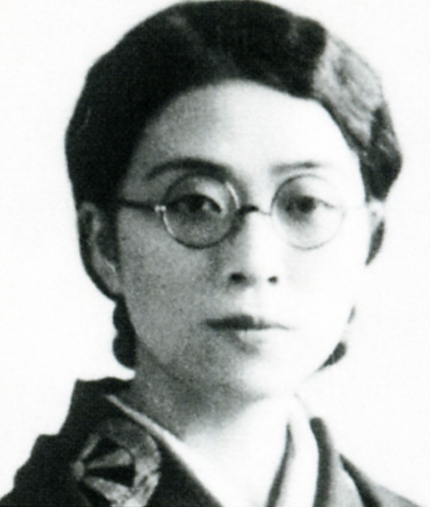- Kikuko Kawakami
Infobox Writer
name = Kikuko Kawakami

caption = Kawakami Kikuko
birthdate = birth date|1898|2|9|df=y
birthplace = Shizuoka,Japan
deathdate = death date and age|1985|10|26|1898|2|9|df=y
deathplace =Kamakura, Kanagawa ,Japan
occupation = writer
genre = novels, poetry
movement =
notableworks =
influences =Hayashi Fusao ,Kawabata Yasunari ,Yosano Akiko
influenced = nihongo|Kikuko Kawakami|川上 喜久子|Kawakami Kikuko|extra=9 February 1904 -26 October 1985 was a Japanese woman writer active inShowa period Japan . Her maiden name was Shinoda Kikuko.Biography
Kawakami Kikuko was born in
Shizuoka Prefecture . She graduated from Heijo Higher Girls' School and from the vocational course at Yamawaki Higher Girls’ School. In 1924 she accompanied her husband toKorea , then under Japanese rule, and lived there until 1931.In 1927, the
Osaka "Asahi Shimbun " awarded her a prize for her novel, "Aru Minikui Biganjutsu-shi" (An Ugly Beautician), which it then ran as a serialized novel in the newspaper.After her return to Japan in 1931, she and her retired husband moved to Kamakura,
Kanagawa prefecture , so that she could receive medical treatment for an illness contracted in Korea. She continued to live in Kamakura until her death in 1985.While living in Kamakura, she had the opportunity to make the acquaintance of some of the Kamakura literati, including
Hayashi Fusao ,Kawabata Yasunari andYosano Akiko (who taught her "tanka)." Some of her poems were accepted byMyōjō .In 1936, Hayashi and Kawabata encouraged Kawakami to publish "Fuyubi no Kage" ("Shadow of a Winter's Day"), "Saigetsu" (Time and tide), and "Metsubo no Mon" ("Gate of Ruin") in "
Bungakukai ", a major monthlyliterary magazine . All three stories were acclaimed byliterary critics , and "Metsubo no Mon" was awarded the eleventh Bungakukai Prize, and was nominated for the 4thAkutagawa Prize .Following this recognition, Kawakami wrote a number of novels in quick succession, including "Hikari Honokanari" (Faint Light), "Biko" ("Dim Light"), and "Hanazono no Shosoku", published in "Bungakukai". Her style was objective and unemotional, and she depicted the ever-increasing oppression under Japan's growing militarism.
After
World War II , Kawakami withdrew from literary activity, but in her later years published "Kagero no Banka" ("Elegy on Mirage").ee also
*
Japanese literature
*List of Japanese authors External links
* [http://www.city.kamakura.kanagawa.jp/english/bunjin/kawakami_e.htm Kamakura Green Net site]
Wikimedia Foundation. 2010.
